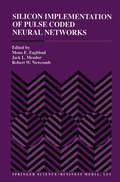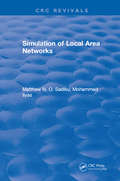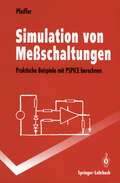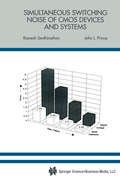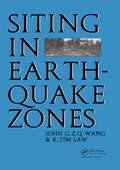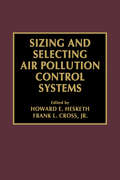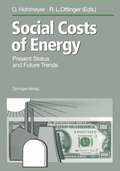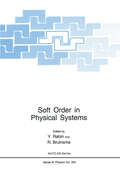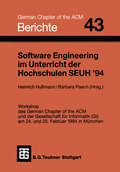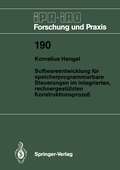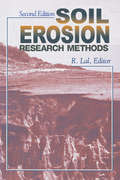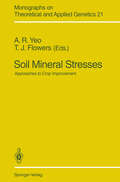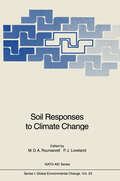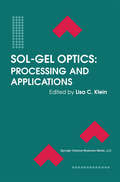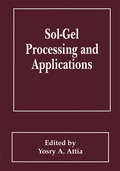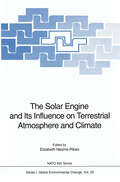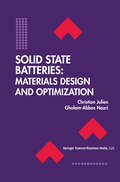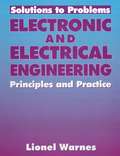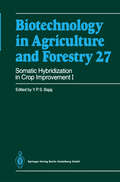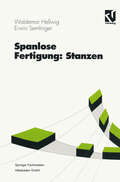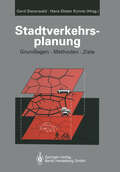- Table View
- List View
Silicon Implementation of Pulse Coded Neural Networks (The Springer International Series in Engineering and Computer Science #266)
by Mona Zaghloul Jack L. Meador Robert NewcombWhen confronted with the hows and whys of nature's computational engines, some prefer to focus upon neural function: addressing issues of neural system behavior and its relation to natural intelligence. Then there are those who prefer the study of the "mechanics" of neural systems: the nuts and bolts of the "wetware": the neurons and synapses. Those who investigate pulse coded implementations ofartificial neural networks know what it means to stand at the boundary which lies between these two worlds: not just asking why natural neural systems behave as they do, but also how they achieve their marvelous feats. The research results presented in this book not only address more conventional abstract notions of neural-like processing, but also the more specific details ofneural-like processors. It has been established for some time that natural neural systems perform a great deal of information processing via electrochemical pulses. Accordingly, pulse coded neural network concepts are receiving increased attention in artificial neural network research. This increased interest is compounded by continuing advances in the field of VLSI circuit design. This is the first time in history in which it is practical to construct networks of neuron-like circuits of reasonable complexity that can be applied to real problems. We believe that the pioneering work in artificial neural systems presented in this book will lead to further advances that will not only be useful in some practical sense, but may also provide some additional insight into the operation of their natural counterparts.
Simulation of Local Area Networks
by Matthew N. SadikuA fast-growing area in the communications industry is the internetworking of an ever-increasing proliferation of computers, particularly via local area networks (LANs). The LAN is a resource-sharing data communications network being used by many offices to interchange information such as electronic mail, word processing, and files among computers and other devices. This unique book shows the user how to establish the performance characteristics of a LAN before putting it to use in a particular type of situation. Simulation of Local Area Networks consists of eight chapters, each with its own extensive list of references. The first chapter provides a brief review of local area networks, and the second chapter gives the analytical models of popular LANs-token-passing bus and ring networks, CSMA/CD LANs, and star networks. Chapter 3 covers general principles of simulation, and Chapter 4 discusses fundamental concepts in probability and statistics relating to simulation modeling. Materials in Chapters 3 and 4 are specifically applied in developing simulation models on token-passing LANs, CSMA/CD LANs, and star LANs in Chapters 5 through 7. The computer code in Chapters 5, 6, and 7 is divided into segments, and a detailed explanation of each segment is provided. The last chapter reviews special-purpose languages such as GPSS, SIMSCRIPT, GASP, SIMULA, SLAM, and RESQ. Helpful criteria for language selection are included. The entire code is put together in the appendixes. This book has two major advantages over existing texts. First, it uses C, a well-developed general-purpose language that is familiar to most analysts. Second, the text specifically applies the simulation principles to local area networks. No other book available shows the systems analyst how to evaluate the performance of existing or proposed systems under different kinds of conditions.
Simulation of Local Area Networks
by Matthew N. SadikuA fast-growing area in the communications industry is the internetworking of an ever-increasing proliferation of computers, particularly via local area networks (LANs). The LAN is a resource-sharing data communications network being used by many offices to interchange information such as electronic mail, word processing, and files among computers and other devices. This unique book shows the user how to establish the performance characteristics of a LAN before putting it to use in a particular type of situation. Simulation of Local Area Networks consists of eight chapters, each with its own extensive list of references. The first chapter provides a brief review of local area networks, and the second chapter gives the analytical models of popular LANs-token-passing bus and ring networks, CSMA/CD LANs, and star networks. Chapter 3 covers general principles of simulation, and Chapter 4 discusses fundamental concepts in probability and statistics relating to simulation modeling. Materials in Chapters 3 and 4 are specifically applied in developing simulation models on token-passing LANs, CSMA/CD LANs, and star LANs in Chapters 5 through 7. The computer code in Chapters 5, 6, and 7 is divided into segments, and a detailed explanation of each segment is provided. The last chapter reviews special-purpose languages such as GPSS, SIMSCRIPT, GASP, SIMULA, SLAM, and RESQ. Helpful criteria for language selection are included. The entire code is put together in the appendixes. This book has two major advantages over existing texts. First, it uses C, a well-developed general-purpose language that is familiar to most analysts. Second, the text specifically applies the simulation principles to local area networks. No other book available shows the systems analyst how to evaluate the performance of existing or proposed systems under different kinds of conditions.
Simulation von Meßschaltungen: Praktische Beispiele mit PSPICE berechnen (Springer-Lehrbuch)
by Wolfgang PfeifferDies ist ein Lehr- und Übungsbuch für die Simulation von elektrischen Schaltungen mit PSPICE, wie sie in der Vorlesung Meßtechnik für Studenten der Elektrotechnik an Hochschulen und Fachhochschulen behandelt werden. Die Grundvorlesungen über elektrische Meßtechnik müssen heutzutage verstärkt auf die Schaltungssimulation eingehen. Das Buch bearbeitet die für die Prüfung und Praxis wichtigsten und aktuellsten Schaltungsbeispiele in anschaulicher Darstellung, wobei auch jeweils die Codierungen in PSPICE mit angegeben werden. Dabei wird auf die Demonstration der typischen und wesentlichen Eigenschaften der Meßschaltungen besonderer Wert gelegt. Es ist sinnvoll und hilfreich, die Beispiele auf dem Rechner mit PSPICE nachzuvollziehen. Aber auch ohne diese Möglichkeit kann das Wesentliche über Meßschaltungen aus diesem Buch gelernt werden.
Simultaneous Switching Noise of CMOS Devices and Systems (The Springer International Series in Engineering and Computer Science #249)
by Ramesh Senthinathan John L. PrinceThis monograph presents our recent research on Simultaneous Switching Noise (SSN) and related issues for CMOS based systems. Although some SSN related work was previously reported in the literature, it were mainly for Emitter Coupled Logic (ECL) gates using Bipolar Junction Transistors (BJTs). This present work covers in-depth analysis on estimating SSN and its impact for CMOS based devices and systems. At present semiconductor industries are moving towards scaled CMOS devices and reduced supply voltage. SSN together with coupled noise may limit the packing density, and thereby the frequency of operation of packaged systems. Our goal is to provide efficient and yet reliable methodologies and algorithms to estimate the overall noise containment in single chip and multi-chip package assemblies. We hope that the techniques and results described in this book will be useful as guides for design, package, and system engineers and academia working in this area. Through this monograph, we hope that we have shown the necessity of interactions that are essential between chip design, system design and package design engineers to design and manufacture optimal packaged systems. Work reported in this monograph was partially supported by the grant from Semiconductor Research Corporation (SRC Contract No. 92-MP-086).
Siting in Earthquake Zones
by John.G.Z.Q Wang K.Tim LawFocusing on fundamental concepts, definitions various aspects of siting, this book contains a detailed checklist to help readers conduct a proper siting process to assess the seismic hazards of a given site. The required site investigation techniques are described in detail.
Siting in Earthquake Zones
by John.G.Z.Q Wang K.Tim LawFocusing on fundamental concepts, definitions various aspects of siting, this book contains a detailed checklist to help readers conduct a proper siting process to assess the seismic hazards of a given site. The required site investigation techniques are described in detail.
Sizing and Selecting Air Pollution Control Systems
by Frank L. Cross Jr. Howard D. HeskethThis book is designed to acquaint the reader with current regulations and with the necessary information to size air pollution control systems. The material presented should also help enable one to select the appropriate equipment for retrofit or new process control, to prepare specifications to purchase equipment, and to prepare permits for air pollution control systems. Sizing and Selecting Air Pollution Control Systems provides guidance to help those responsible for air pollution control to specify systems which are cost-effective and energy-efficient to meet the needs of their employers and the government. When equipment specifications are properly prepared, they provide for an easier comparison of competitive bids of those devices capable of meeting standards reliably and economically.
Sizing and Selecting Air Pollution Control Systems
by Frank L. Cross Jr. Howard D. HeskethThis book is designed to acquaint the reader with current regulations and with the necessary information to size air pollution control systems. The material presented should also help enable one to select the appropriate equipment for retrofit or new process control, to prepare specifications to purchase equipment, and to prepare permits for air pollution control systems. Sizing and Selecting Air Pollution Control Systems provides guidance to help those responsible for air pollution control to specify systems which are cost-effective and energy-efficient to meet the needs of their employers and the government. When equipment specifications are properly prepared, they provide for an easier comparison of competitive bids of those devices capable of meeting standards reliably and economically.
Social Costs of Energy: Present Status and Future Trends
by Olav Hohmeyer Richard L. OttingerAlthough present day politics seems to be preoccupied with questions of economic growth and full employment, the basic environmental problems stemming from the interactions of the economic sphere with global, regional and local environments persist and will have an even greater impact in the future. If economy and ecology are not reconciled in the years to come, mankind will not have a sustainable future on Earth. The typical negation of environmental problems in times of economic crisis is partially due to the fact that environmental and health damages of economic activities are neither priced nor included in our market price system. This allows politicians to focus their attention on insufficient economic indicators which do not reflect the actual development of the welfare of society. If economic lead indicators like GDP or balance of trade figures were better integrated with information on the environmental and health costs caused by the seemingly beneficial economic development, politicians might have better guidance as to what policy choices would benefit society most.
Soft Order in Physical Systems (Nato Science Series B: #323)
by R. Bruinsma Y. RabinA humoristic view of the physics of soft matter, which nevertheless has a ring of truth to it, is that it is an ill-defined subject which deals with ill-condensed matter by ill-defined methods. Although, since the Nobel prize was awarded to Pierre-Gilles de Gennes, this subject can be no longer shrugged-away as "sludge physics" by the physics community, it is still not viewed universally as "main stream" physics. While, at first glance, this may be considered as another example of inertia, a case of the "establishment" against the "newcomer", the roots of this prejudice are much deeper and can be traced back to Roger Bacon's conception about the objectivity of science. All of us would agree with the weaker form of this idea which simply says that the final results of our work should be phrased in an observer-independent way and be communicable to anybody who made the effort to learn this language. There exists, however, a stronger form of this idea according to which the above criteria of "objectivity" and "communicability" apply also to the process of scientific inquiry. The fact that major progress in the physics of soft matter was made in apparent violation of this approach, by applying intuition to problems which appeared to defy rigorous analysis, may explain why many physicists feel somewhat ill-at-ease with this subject.
Software Engineering im Unterricht der Hochschulen SEUH ’94 (Berichte des German Chapter of the ACM)
by Heinrich Hussmann Barbara PaechSoftwareentwicklung für speicherprogrammierbare Steuerungen im integrierten, rechnergestützten Konstruktionsprozeß (IPA-IAO - Forschung und Praxis #190)
by Kornelius HengelSoil Erosion Research Methods
by Soil and Water Conservation Society (U. S.)This new edition of Soil Erosion Research Methods retains the themes and layout of the first edition. However, most chapters have been revised and some additional chapters have been added. There are new chapters on modeling wind and water erosion. Extensive revisions and updating have been done in chapters dealing with assessment of erosivity and erodibility, erosion, crop productivity, measuring sediment yield from river basins and field plot techniques. There is extensive updating of current statistics on the global magnitude of soil erosion by water and wind and on denudation rates. Several new authors have made significant improvements in revising and updating available information.
Soil Erosion Research Methods
by Soil and Water Conservation Society (U. S.)This new edition of Soil Erosion Research Methods retains the themes and layout of the first edition. However, most chapters have been revised and some additional chapters have been added. There are new chapters on modeling wind and water erosion. Extensive revisions and updating have been done in chapters dealing with assessment of erosivity and erodibility, erosion, crop productivity, measuring sediment yield from river basins and field plot techniques. There is extensive updating of current statistics on the global magnitude of soil erosion by water and wind and on denudation rates. Several new authors have made significant improvements in revising and updating available information.
Soil Mineral Stresses: Approaches to Crop Improvement (Monographs on Theoretical and Applied Genetics #21)
by Anthony R. Yeo Timothy J. FlowersSoil Responses to Climate Change (Nato ASI Subseries I: #23)
by Mark D. A. Rounsevell Peter J. LovelandSoils will play a central role in mediating the impact of climate change on natural and managed ecosystems. The book addresses the various responses of soil processes and properties to environmental change and highlights their contribution to the proper understanding of ecosystem behaviour.Topics include: Soil hydrology; landscape evolution; salinisation; desertification; soil nitrogen dynamics; soil carbon; soil microbiology; soil erosion; crop modelling.
Sol-Gel Optics: Processing and Applications (The Springer International Series in Engineering and Computer Science #259)
by Lisa C. KleinSol--Gel--Optics encompasses numerous schemes for fabricating optical materials from gels -- materials such as bulk optics, optical waveguides, doped oxides for laser and nonlinear optics, gradient refractive index (GRIN) optics, chemical sensors, environmental sensors, and `smart' windows. Sol--Gel--Optics: Processing and Applications provides in-depth coverage of the synthesis and fabrication of these materials and discusses the optics related to microporous, amorphous, crystalline and composite materials. The reader will also find in this book detailed descriptions of new developments in silica optics, bulk optics, waveguides and thin films. Various applications to sensor and device technology are highlighted. For researchers and students looking for novel optical materials, processing methods or device ideas, Sol--Gel--Optics: Processing and Applications surveys a wide array of promising new avenues for further investigation and for innovative applications. (This book is the first in a new subseries entitled `Electronic Materials: Science and Technology).
Sol-Gel Processing and Applications
by Yosry AttiaDuring my professional career, I developed a strong interest in sol-gel technology, and worked on both xerogel and aerogel systems. My fascination with aerogels has driven me to explore their commercial potential, which is currently an important component of my company's business plan. Together with my co-workers, I have also worked on the preparation of controlled PZT and silica xerogels as well as thin film coatings of metals by the sol-gel technology, These experiences convinced me of the tremendous potentials of this technology. A conviction that is shared by many scientists, engineers, and business leaders around the globe. Many sol-gel derived products are already articles of commerce. However, to expand the commercial potential of sol-gel technology, two challenges must be met: (1) the quality of sol-gel derived products must continue to meet or exceed the quality of competing products, (2) the production cost of sol-gel products (specially aerogels) must continued to decline. A key to lowering the costs of sol-gel products is finding inexpensive precursors.
The Solar Engine and Its Influence on Terrestrial Atmosphere and Climate (Nato ASI Subseries I: #25)
by Elizabeth Nesme-RibesThe message of sunspots from the interior of the Sun to the Earth's climate When Galileo was summoned before the Inquisition on April 12, 1633, the main accusations laid against him concerned the doubts he expressed about Aristotle's theory of the universe. Aristotle's idea was that the Earth was the centre of the cosmos and that all of the stars, including the Sun, turned around it. Moreover, for Aristotle and the world of the Inquisitors, the Sun was a perfect celestial body. Now, Galileo had discovered spots on the Sun. These spots were seen as imperfections, and not just surface markings, but coming from within the Sun. Worse yet, they revolved around the Sun. All this supported the newfangled theory of Copernicus, and undermined a system of thought that had reigned supreme for centuries. Man of science that he was, and a prudent Catholic too, Galileo strived all his life to prove that Copernicus' astronomical concept was compatible with the word of the Bible. He proposed that there were not two truths but a single divine truth. It was just expressed in two different languages : there was the language of the common people, with its imprecision and inconsistencies, but intuitively understandable by everyone; and then there was the precise language of science with its strict regard for observation, which only a chosen few can grasp [L. Geymonat. 1992].
Solid State Batteries: Materials Design and Optimization (The Springer International Series in Engineering and Computer Science #271)
by Christian Julien Gholam-Abbas NazriThe field of solid state ionics is multidisciplinary in nature. Chemists, physicists, electrochimists, and engineers all are involved in the research and development of materials, techniques, and theoretical approaches. This science is one of the great triumphs of the second part of the 20th century. For nearly a century, development of materials for solid-state ionic technology has been restricted. During the last two decades there have been remarkable advances: more materials were discovered, modem technologies were used for characterization and optimization of ionic conduction in solids, trial and error approaches were deserted for defined predictions. During the same period fundamental theories for ion conduction in solids appeared. The large explosion of solid-state ionic material science may be considered to be due to two other influences. The first aspect is related to economy and connected with energy production, storage, and utilization. There are basic problems in industrialized countries from the economical, environmental, political, and technological points of view. The possibility of storing a large amount of utilizable energy in a comparatively small volume would make a number of non-conventional intermittent energy sources of practical convenience and cost. The second aspect is related to huge increase in international relationships between researchers and exchanges of results make considerable progress between scientists; one find many institutes joined in common search programs such as the material science networks organized by EEC in the European countries.
Solutions Manual to Electronic and Electrical Engineering: Principles and Practice
by Lionel WarnesContains the fully worked solutions to the 300 problems included at the end of chapters in Electronic and Electrical Engineering. Also contains numerous line diagrams.
Somatic Hybridization in Crop Improvement I (Biotechnology in Agriculture and Forestry #27)
by Y. P. BajajSpanlose Fertigung: Stanzen (Viewegs Fachbücher der Technik)
by Waldemar HellwigDie spanlose Fertigung erlaubt bei geringem Werkstoff-Abfall große Mengen von Werkstücken aus Metall oder anderen Werkstoffen in kurzer Zeit zu produzieren und erlangt deshalb eine wachsende volkswirtschaftliche Bedeutung. Das Fertigungsver fahren, das sich für die Herstellung einer größeren Anzahl von gleichen Teilen (Werk stücken) aus Bändern, Blechen oder Stäben eignet, wird als Stanzen bezeichnet. Es ist in der Regel ein zusammengesetztes Verfahren, das die Teile (Stanzteile) in einer oder mehreren Arbeitsfolgen innerhalb einer Stanzmaschine spanlos herstellt. Es kann sich aus Trennen (Schneiden) und Umformen zusammensetzen, wobei zum Umformen das Biegen, Ziehen und Prägen gehören kann. Zusätzliche Verfahren, wie Fügen, Nieten, Gewindeschneiden, Schweißen und Laserschneiden, werden dazu ebenfalls einbezogen und erweitern somit die Formenvielfalt der Stanzteile. Stanzteile sind Werkstücke, zu deren Herstellung die genannten Verfahren des Tren nens, Umformens, Fügens usw. angewandt werden. Sie werden durch zweiteilige formgebende Werkzeuge erzeugt. Als Arbeitsmaschinen dazu werden mechanische oder hydraulische Pressen verwendet, die eine geradlinige Hubbewegung ausführen. Für die Fertigungsgenauigkeit der Stanzteile ist die Form- und Maßgenauigkeit des Werkzeuges und die Führungsgenauigkeit der Maschine in der Arbeitsebene maßge bend. Der Begriff Stanztechnik kann also mehrere Verfahren integrieren und entzieht sich ei ner Einordnung in die Fertigungsverfahren nach DIN 8580. Gleichwohl haben sich industriell spezialisierte Stanztechniken entwickelt, die man wie folgt einteilen kann: 1. Konventionelle Stanztechnik 2. Hochleistungs-Stanztechnik 3. Feinstanztechnik 4. Nibbel-und Laserschneidtechnik 5. Großteil-Stanztechnik Die konventionelle Stanztechnik produziert Stanzteile mit mittleren Toleranzanforde rungen bei mittleren Hubfrequenzen und benutzt noch vielfach Werkzeugstähle in den Werkzeugen. Die Maschinenrahmen sind oft als C-Rahmen ausgeführt.
Stadtverkehrsplanung: Grundlagen - Methoden - Ziele
by Gerd Steierwald Hans-Dieter Künne Walter VogtIn einer Zeit des Umbruchs, des fortwährenden Wandels in den Wertvorstellungen, der Zu kunftsängste, aber auch der fortschreitenden Entwicklung der Technik und des planerischen Instrumentariums, in einer solchen Zeit ein Buch über die Grundlagen der Stadtverkehrsplanung herauszugeben, muß als Wagnis bezeichnet werden, das die Verfasser nicht leichtfertig auf sich genommen haben. Sie sind der Auffassung, daß jenseits der vielfältigen, emotional kritischen Diskussionen sowohl die methodischen Grundlagen als auch die praktischen Ansätze einen Standard erreicht haben, der in einem Überblick dargestellt werden sollte. Die Fülle des Stoffes erlaubt kein abschließendes Kompendium. Wichtig erschien den Her ausgebern, daß - neben den allgemeinen Beschreibungen und teilweise auch mit Wertungen ver bundenen zukunftsbezogenen Aussagen - die verschiedenen analytischen, prognostischen und konstruktiv-planerischen Schritte der Verkehrsplanung deutlich gemacht werden. Die Autoren können dabei auf eine umfangreiche Literatur verweisen. Der Praxis stehen zahlreiche Richtli nien und Empfehlungen anerkannter Institutionen (z.B. der Forschungsgesellschaft für Straßen und Verkehrswesen) zur Verfügung, deren flexible Handhabung gerade in Zeiten eines dynami schen Wandels an Bedeutung zunimmt. Die Darstellung beschränkt sich auf die Grundlagen der Planung und des Entwurfs städtischer Verkehrsanlagen und schließt die Behandlung von Themen der Verkehrstheorie, der Verkehrs leittechnik, des Verkehrsmanagements und der Informations- und Kommunikationssysteme aus, da sie den Rahmen dieses Handbuches sprengen würden.
